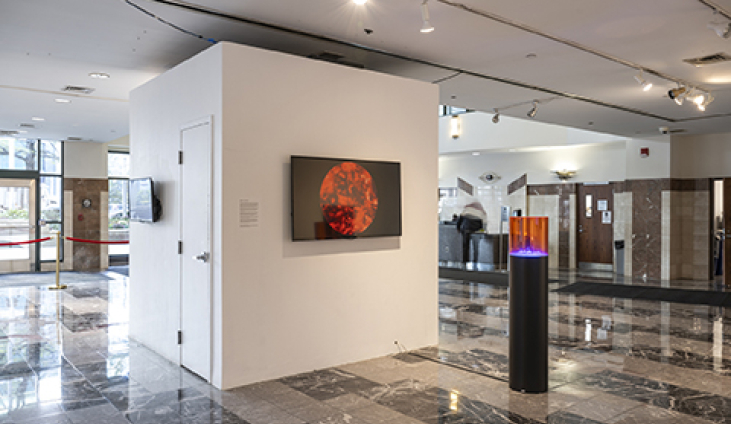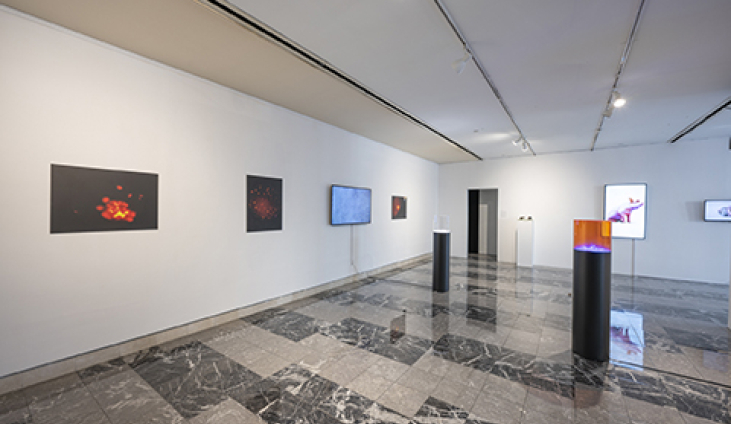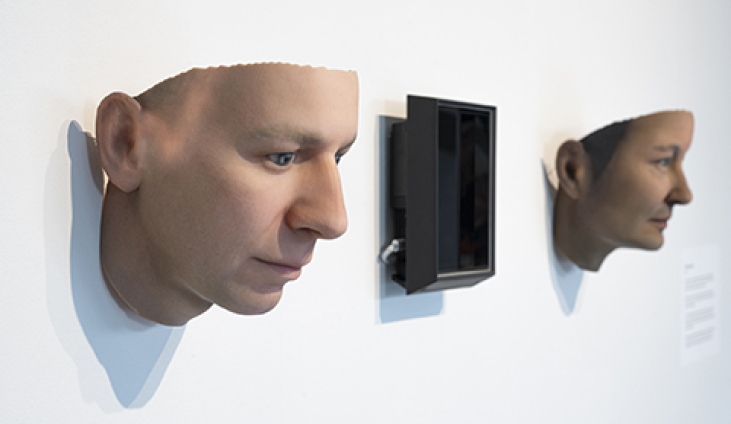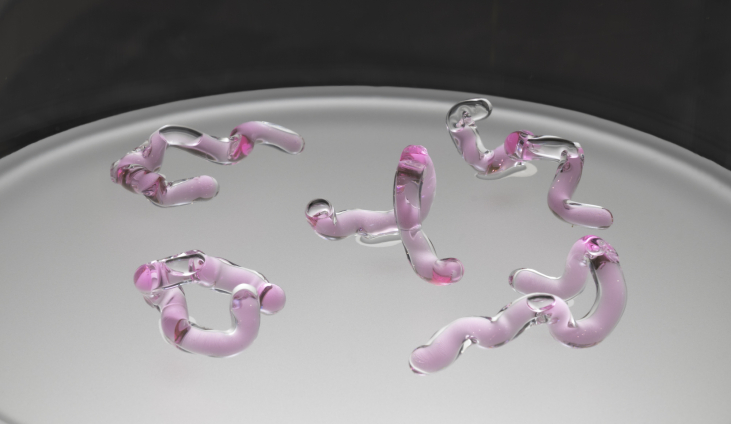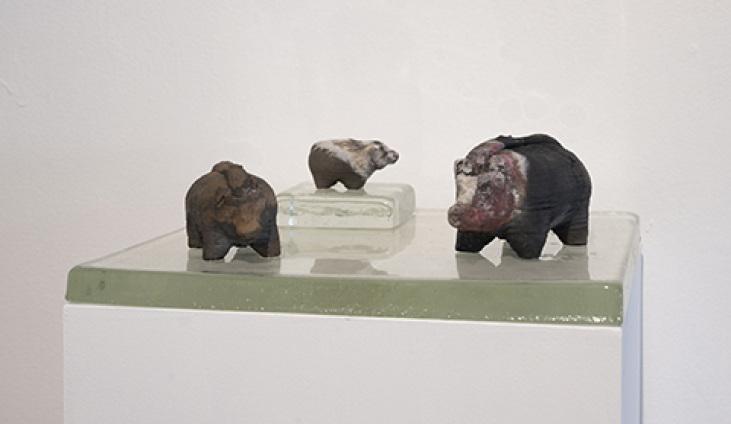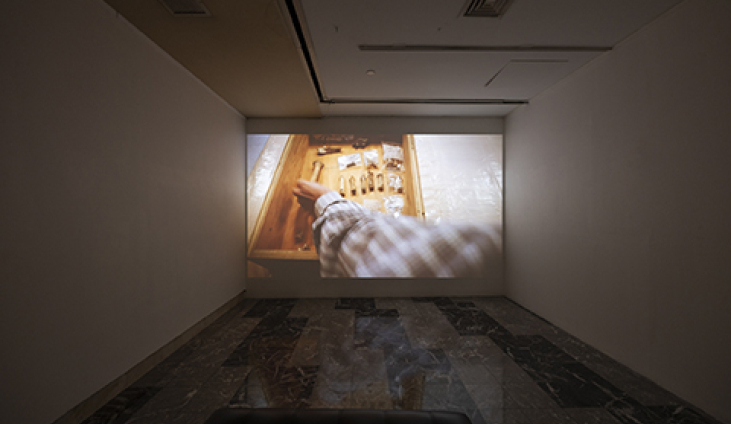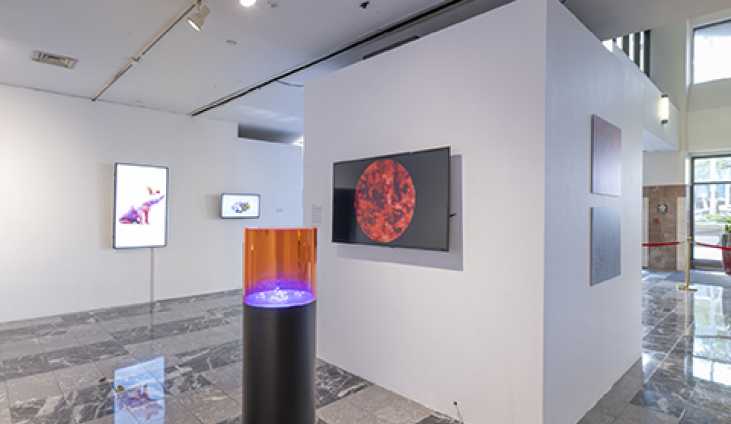The title ‘Closer Than Your Family’ is pulled from the libretto of Heather Dewey-Hagborg’s most recent work, ‘Hybrid: An Interspecies Opera,’ a short film exploring the layered implications of xenotransplantation. Its subjects are real-life humanoid-pigs, genetically engineered to be compatible heart donors for transplants. The opera consists of five parts, exploring the interwoven history of humans and our porcine counterparts. Introduced as a ‘musical tribute,’ the operatic form points to the tragedy and sacrifice of these creatures, whose pleading eyes and tactile heartbeat the artist faithfully records on-site at rarely seen research facilities. The voices sing: ‘This is a human. This is a humanized-pig.’
The original score was composed by Bethany Barett and based on interviews conducted by Heather Dewey-Hagborg. Its haunting choral refrains are quotes from scientists and archaeologists, the melodies imbuing facts and figures with emotional resonance and proximity. The musical form functions as a Greek chorus, where the audience is guided through complicated themes and feelings with repetition. The rhythmic device mediates the space between us and them, leaving no doubt that this story is a shared tragedy. The voices sing: ‘There is a guilt. There is a betrayal.’
Through the artist’s lens we see remnants of bones evidencing domestication, we see ancient artifacts venerating pigs, we see modern-day labs harvesting tissue. Layers of history are methodically exposed, revealing an interconnected narrative and its inherent anthropocentrism. Through selective breeding and genetic re-engineering, we have been tinkering with the pig for centuries to better serve our needs, each step bringing them closer to family. In ancient myth, Circe transforms Odysseus’s crew into swine. When he pleads to return the men to human form, she counsels “These creatures are no run of the mill. You must ask them first if they are willing.”* The pigs memorialized in Dewey-Hagborg’s Hybrid are not able to register consent or refusal. They are raised and will die to save countless human lives. The voices sing: ‘This deed was done by all of us.’
Heather Dewey-Hagborg’s work is visually sumptuous and critically loaded; it is based in cutting edge science, but speaks to us as fellow humans, confronting our limitations and potentials.
In a companion series titled Future Pigs, Plural, computer-animated imagery depicts speculative outcomes for the species. In subtly animated vignettes, once-pigs are resplendent in brightly hued fur and animal prints, enlarged to carry more offspring, or anthropomorphized further. These variations exist within the realm of the possible, placing them outside of an Atwoodian definition of science fiction and into a shared reality.
Permutations are also explored in Watson’s Ghost, a 2021 body of work that uses the publicly published genome of James Watson, co-discoverer of the double-helix, to extrapolate a range of portraits. Two 3D printed busts flank a holographic video that shuffles through different bio-visualizations of the controversial scientist, whose reductionist and racist views are now widely rebuked but institutionally ingrained. His image flickers in and out, changing slightly with each potential visage. The artist reminds us “this ghost of eugenic belief continues to haunt the study of genetics to this day.”
Watson’s 1965 textbook ‘Molecular Biology of the Gene’ served as an introduction to the new field, which has continued to exponentially expand in the decades since its publication. Across the street from the gallery at the biotech company Integral Molecular, scientists develop technologies that aid in research and vaccine development Beyond developing life changing technologies, Integral Molecular is serves as host to an innovative BioArt Residency, working with Heather Dewey-Hagborg to create Lovesick: The Transfection, a bespoke retrovirus that ‘infects its human host with a gene that increases the production of oxytocin.’ In theory, it is capable of -literally- spreading the love.
Large moving images of fluorescent microscopy show the virus transfecting cells, awash in red, while an inactive version of the virus is displayed in small glowing glass vials. In the accompanying audio work, we hear the precious containers being smashed, broken open and consumed orally in an imagined ritual of attachment and empathy.
The score from Hybrid barely is audible in the distance. The voices repeat: ‘There is a guilt. There is a betrayal.’
You can sense sorrow and promise simultaneously throughout this powerful exhibition. Heather Dewey-Hagborg’s work is visually sumptuous and critically loaded; it is based in cutting edge science, but speaks to us as fellow humans, confronting our limitations and potentials. As this final exhibition demonstrates so clearly, the Esther Klein Gallery was a space where scientific thought convened with community. When ‘Closer Than Family’ closes this December, the gallery will be gone, but art will live on at the Science Center. Incredible scientific advances will continue to be made in labs across the street, throughout the city, and around the world -often at rates quicker than public discourse. Over the past 45 years, we were invited to join the creative dialog, to reflect on our complicity and responsibility, and to imagine shared futures through the innovative exhibitions at the Esther Klein Gallery. This was a gift.

